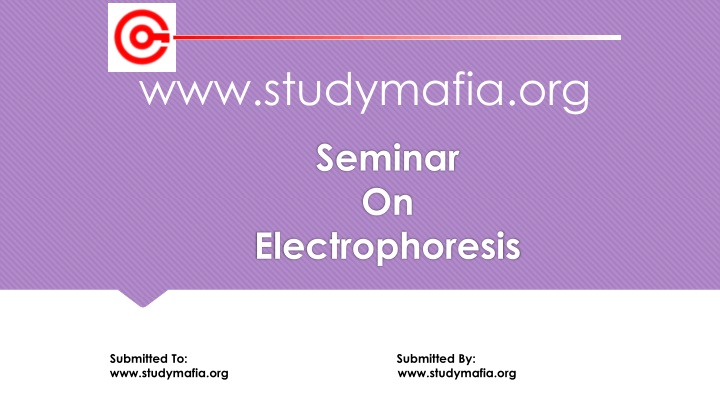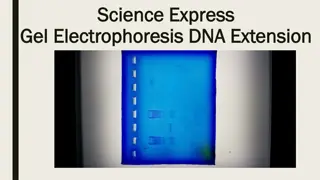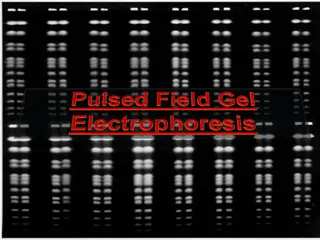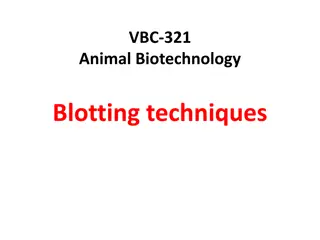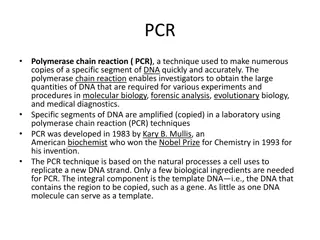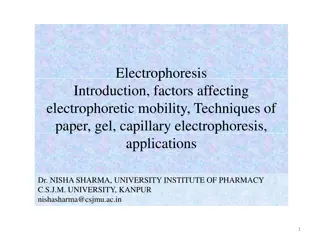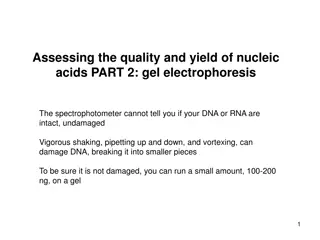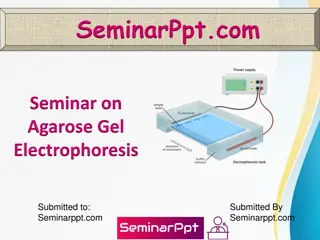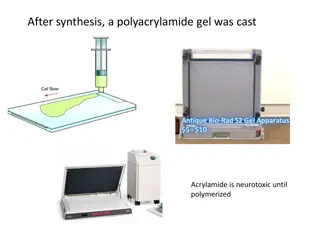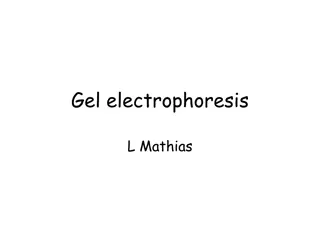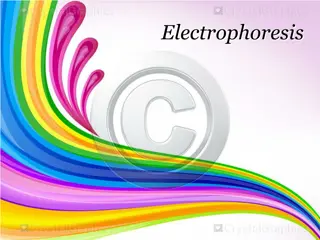Seminar on Electrophoresis - A Laboratory Technique for Molecule Separation
Electrophoresis is a laboratory technique used to separate DNA, RNA, or protein molecules based on size and charge. By applying an electric field, molecules migrate through a gel at different rates, allowing for precise separation and analysis, commonly used in molecular biology and medical diagnostics.
Download Presentation

Please find below an Image/Link to download the presentation.
The content on the website is provided AS IS for your information and personal use only. It may not be sold, licensed, or shared on other websites without obtaining consent from the author.If you encounter any issues during the download, it is possible that the publisher has removed the file from their server.
You are allowed to download the files provided on this website for personal or commercial use, subject to the condition that they are used lawfully. All files are the property of their respective owners.
The content on the website is provided AS IS for your information and personal use only. It may not be sold, licensed, or shared on other websites without obtaining consent from the author.
E N D
Presentation Transcript
www.studymafia.org Seminar On Electrophoresis Submitted To: www.studymafia.org www.studymafia.org Submitted By:
Table of Content Introduction Definition of Electrophoresis Principle of Electrophoresis How does it work? Electrophoresis types Gel electrophoresis procedure Applications Advantages of Electrophoresis Disadvantages of Electrophoresis Conclusion References
Introduction Suppose you have just done a PCR reaction, making many copies of a target DNA region. Or perhaps you ve done some DNA cloning, trying to "paste" a gene into a circular DNA plasmid. Now, you want to check and see whether your PCR worked, or whether your plasmid has the right gene in it. What technique can you use to visualize (directly observe) the fragments of DNA?
Definition Electrophoresis is a laboratory technique used to separate DNA, RNA, or protein molecules based on their size and electrical charge. An electric current is used to move molecules to be separated through a gel. Pores in the gel work like a sieve, allowing smaller molecules to move faster than larger molecules. The conditions used during electrophoresis can be adjusted to separate molecules in a desired size range.
Principle of Electrophoresis Electrophoresis is based on the phenomenon that most biomolecules exist as electrically-charged particles, possessing ionizable functional groups. Biomolecules in a solution at a given pH will exist as either positively or negatively charged ions. When subjected to an electric field, ionized biomolecules will migrate at a different pace, depending on the mass and the net charge of each particle in the solution negatively-charged particle, anions, will migrate towards a positively charged electrode, or cathode, and cations, or positively-charged particles, will be pulled towards a negatively-charged electrode called anode.
How does it work? An electric field is applied to molecules and as they are electrically charged themselves it results in a force acting upon them. The greater the charge of the molecule the greater the force applied by the electrical field and therefore the further through the support medium the molecule will move relative to its mass. Some example applications of electrophoresis include DNA and RNA analysis as well as protein electrophoresis which is a medical procedure used to analyse and separate the molecules found in a fluid sample (most commonly blood and urine samples).
Electrophoresis types This technique is divided into two types viz slab electrophoresis and capillary electrophoresis. Types of Electrophoresis: Capillary electrophoresis Gel electrophoresis Paper electrophoresis Slab electrophoresis Zone electrophoresis Immunoelectrophoresis Isoelectrofocusing
Capillary electrophoresis Capillary electrophoresis is an analytical technique that separates ions based on their electrophoretic mobility with the use of an applied voltage. The electrophoretic mobility is dependent upon the charge of the molecule, the viscosity, and the atom's radius. The rate at which the particle moves is directly proportional to the applied electric field-- the greater the field strength, the faster the mobility. Neutral species are not affected, only ions move with the electric field. If two ions are the same size, the one with greater charge will move the fastest.
Slab electrophoresis It is primary method used in Clinical chemistry lab. It has ability to Simultaneously separate Several samples in one run. It uses a rectangular gel Regardless of thickness. Gels are cast on sheets of Plastic backing. It is useful in separation of isoenzymes, Lipoproteins, Hemoglobin & fragments Of DNA & RAN Slab Gel Electrophoresis is a type of Gel electrophoresis The gel is set or polymerized into a thin slab between two glass plates.
Gel electrophoresis procedure Below we have explained the steps conducted during DNA electrophoresis. Step 1: Prepare sample Isolate the DNA and prepare the solution by adding blue dye so that it will be easy to observe the movement of the sample taking place in the gel. Step 2: Prepare an agarose TAE gel solution TAE buffer solution helps to generate an electric field during the process of electrophoresis. To prepare the solution, for example, if there is a requirement of 1% agarose gel then add 100mL TAE to 1 g of agarose. The higher percentage of agarose will give a denser screen. Dissolve the agarose by heating the agarose TAE solution.
Gel electrophoresis procedure Contt. Step 3: Gel casting along with the wells is ready to use for the experiment. Pour the agarose TAE solution in a casting tray. Allow it to cool and solidify. A gel slab Step 4: How to set up the electrophoresis chamber? position such that it is near the negative electrode. Fill a chamber with TAE buffer. Place the solid gel in the chamber. Place the gel in such a Step 5: Gel loading Load the wells with the DNA sample and DNA ladder (a reference for sizes).
Gel electrophoresis procedure Contt. Step 6: Process of electrophoresis Connect the positive and negative points to the power supply and chamber. Switch on the power and migration in the DNA sample due to the electric field generated. The negatively charged sample will move towards the positive point and away from the negative electrode. Step 7: Observe the DNA Once you see the migration of the blue colored DNA samples in the gel switch off the power supply. Remove the gel and place it in the ethidium bromide solution. Step 8: Expose the ethidium bromide stained gel under UV light and take a picture. DNA bands appear in the lane of respective well. Also, the DNA ladder is visible. Therefore, the length of DNA bands can be determined. Below is the image of the experiment conducted.
Applications for Electrophoresis Antibiotic testing: Antibiotics help medical patients fight off illnesses and infections. Today, antibiotics are widely used for medical applications, but they must be researched extensively to ensure their safety, purity and effectiveness. Electrophoresis is used to separate the antibodies in the antibiotic from any impurities. This process also enables researchers to determine the concentration of the antibiotic, making dosage more accurate. DNA analysis: DNA analysis is one of the most common applications for electrophoresis. Using gel as a medium, researchers can stratify DNA into segments using an electrical charge and keep the molecules in place once the charge is removed. This allows researchers to examine molecules at high resolutions, making it much easier to thoroughly analyze DNA structures.
Applications for Electrophoresis Contt Vaccine testing: Vaccines have saved countless lives and radically reduced the spread of diseases like measles and pertussis. Electrophoresis has played an essential role in the development of modern vaccines; it is used to test the purity and concentration of vaccines. Researchers use electrophoresis to test variations of vaccines with different levels and types of antibodies to conduct studies to find the best possible version of a single vaccine. Analysis of proteins and antibodies: Another key application for electrophoresis is protein and antibodies analysis. Electrophoresis that s used for this application is called immunoelectrophoretic, and it allows research to study the interactions between proteins and antibodies.
Advantages (a) High separation efficiency (b) Short analysis time (c) Low sample and electrolyte consumption (d) Low waste generation (e) Ease of operation
Disadvantages Electrophoresis Has Limited Sample Analysis Electrophoresis Measurements Are Not Precise Substantial Starting Sample is Required Only Certain Molecules Can Be Visualized Electrophoresis is Low Throughput
CONCLUSION Although the existence of some pitfalls such as contamination or species conversion cannot be ig-nored, gel electrophoresis is a powerful tool for the fractionation or separation of high-molecular-masscompounds, such as metalloproteins. The two main separation modes, one- or two-dimensional, offer areal separation of the proteins. While non-denaturing 2DE still has to be further developed, denaturing2DE is already a very powerful separation technique for covalently bound elements, such as Se or evenphosphorus and sulfur.
References www.google.com www.wikipedia.com www.studymafia.org
